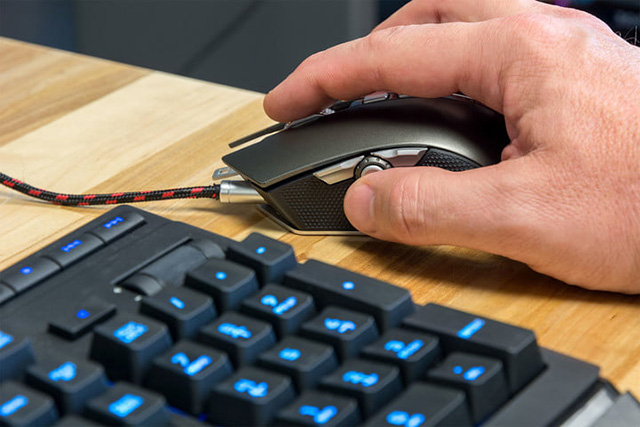Differentiate optical mice and laser mice
Difference between optical mouse and laser mouse
Today, computer mice are one of the most popular and indispensable devices for people who regularly use computers.This item can easily be found on technology shelves with all different sizes.On the market today, the majority of computer mice are designed to be suitable for right-handed users, while the rest are for left-handed people.
Based on features and features that can split the computer mouse, it is now made into two types: one uses optical sensors and the other is laser-based.So have you ever felt awkward about the difference between optical mice and laser mice?
 Differentiate optical mice and laser mice Picture 1
Differentiate optical mice and laser mice Picture 1
Category
- Difference between optical mouse and laser mouse
- Do you believe it? Computer mice are optical devices
- Laser mice use invisible light with high accuracy
- The fight begins
- Accuracy and sensitivity
- Which is better?
Do you believe it? Computer mice are optical devices
Modern computer mice are basically camera devices.It may sound strange but if you look at how the computer mouse works, you will find that this is true.While we use the mouse, we will continuously capture images of the surface we hover over.However, these photos are not intended to be viewed but are not works of art either, they are converted into data that indicates the current position of the device on the surface of use.In short, understand that you are holding a low resolution camera in other words a CMOS sensor (Complementary Metal-Oxide Semiconductor).With two lenses and a light source this sensor captures thousands of shots every second to track the device's position changes.
Technically, computer mice are an optical device because they capture images during operation, which is optical data.However, in the market, many computer mice are considered an optical device because they emit red LED light when used.This lightis emitted from an LED bulb placed behind a lens to focus light into a beam.This beam shines down to the surface and then bounces back through the lens.These lenses enlarge the beam before they reach the CMOS sensor.
 Differentiate optical mice and laser mice Picture 2
Differentiate optical mice and laser mice Picture 2
CMOS sensors collect the light beam and then convert them into an electric current.This analog data is then converted in the form of data 1 and 0, the process is the result of 10,000 digital images captured every second.As mentioned, these images are analyzed, compared to determine the exact position of the mouse on the surface, and then the final data is sent to the computer to locate the mouse cursor on the screen. picture with accuracy of up to eight milliseconds.
If you look at older LED mice, you will see the LED illuminated in a straight-down direction and emit a red beam on the surface that the sensor will capture.In the generation of mice a few years later, the LED lights in a corner and is often in the form of infrared so we cannot see it.This helps the mouse track its movements on most surfaces.
Laser mice use invisible light with high accuracy
In 2004 Logitech gained a major boost when it introduced the first laser mouse.Specifically, this mouse is called a vertical-cavity surface-emitting laser diode (VCSEL) - a technology commonly found in laser pointers, optical drives, barcode readers and many other devices.
Infrared laser on this mouse to replace the infrared LED, the red LED is often seen before.Don't worry about these light being harmful to your eyes because the laser used on this device is not too strong (however, saying that doesn't mean you can stare at it for a few minutes). .These infrared rays are also outside the spectrum that the naked eye can see.Therefore you will not have to see unpleasant red light coming from below your mouse.
 Differentiate optical mice and laser mice Picture 3
Differentiate optical mice and laser mice Picture 3
At times, laser mice are said to have far superior features compared to conventional optical mice.However, over time, optical mice have improved a lot and now they work well in many different situations with high accuracy.The biggest advantage of laser mice is that they have a higher sensitivity than conventional LED mice, but in fact, unless you are a gamer for normal users, this advantage is not a thing. too important.
The fight begins
So if the big difference between the optical mouse and the laser mouse is at the light source they use, what is the biggest difference that users will experience in using these two mice?
First, both types of mice collect surface information to track their position on that surface.But the advantage of lasers is that they can penetrate deeper into the surface structure without affecting the surface.This makes the CMOS sensor and processor inside the mouse more informative.
For example, although very clear and smooth, the glass surface still has extremely small irregularities and the laser can easily identify these irregularities, thereby allowing users to hover. on the glass surface.Meanwhile, even the most modern optical mouse cannot work on glass surfaces.Even if you put the glass on another black surface, the optical mouse still cannot determine its position on the surface, but if you remove the glass, the optical mouse works normally.
Of course, you rarely have to use a mouse on a glass surface, but the example above shows how two different lighting processes are in terms of performance.LEDs will only track the anomalies found on the top layer of the surface, while a laser can go much deeper to exploit more details.So optical mice work best on non-glossy surfaces and especially on mouse pads, while laser mice can operate on any glossy surface.
Accuracy and sensitivity
The problem with laser mice is that they are too accurate and collect too much unnecessary information about the surface it is operating.This can lead to problems because when we hover at a slow speed, the cursor on the screen is vulnerable to "jitter".As a result, some excess information is also thrown in with the information needed to send to the PC and the cursor will not appear in the exact position on the screen, at the exact time you intended.Although this problem has improved over the years, laser mice are still not an ideal choice if you are performing tasks that require meticulousness and high precision, for example when you sketch. details in Adobe Illustrator.
It can be said that the jitter phenomenon has nothing to do with the number of details a laser mouse can receive per second, which is associated with the entire process from laser surface scanning, information gathering, information processing. , until such information is sent to the computer.To reduce jitter, you can hover your mouse over the fabric surface, and place another dark, hard surface below, so that the laser will not collect unnecessary garbage data.
Another method is to reduce the sensitivity of the mouse.The resolution of CMOS sensor on the mouse is different from that on the camera because it works based on motion.The sensor includes a certain number of physical pixels that are aligned and placed in a square grid.The resolution of the image is derived from the number of individual images taken by a pixel in each physical motion on a surface.Because these physical pixels have a constant size, the sensor can use images to divide each pixel into smaller parts.This suggests that all mice have a certain physical resolution and increased sensitivity comes from the fact that the algorithm in the sensor automatically increases the movement of the cursor on the screen, despite moving the animal. The reason for the mouse remains unchanged.Therefore, the closer you get to the basic resolution, the more sensors in a laser mouse will collect less garbage data.Simply put, lower sensitivity also leads to more precise movement.
Which is better?
This depends on many different factors.For example, with the Logitech G brand, you can see that Logitech is primarily focused on developing LED mice for the PC gaming market.That's because most of their customers are people who often use computers on their desks, and they may even be using a mouse pad designed with good friction.These PC gamers simply don't want any accuracy errors.
However, laser mice are not a loser, Logitech still produces a small number of laser mice for ordinary users.In contrast, one of Logitech - Razer's biggest competitors, has a huge list of laser mouse products.Razer likes laser technology because it provides better sensitivity for high-speed motion in the game.In general, it's hard to say that any optical mouse or laser can fight all kinds of games.
A laser mouse can be the ideal companion when you're in a hotel room, lying on a couch in the living room at home, surfing Facebook in Starbucks, or in a board meeting.In these situations the performance of the laser mouse is better than that of the optical mouse.You will find a laser mouse useful when you need to put your mouse on your lap to use it, or when your office is full of shiny furniture.Most high-end and expensive mice use laser technology.Of course they are also more expensive because lasers are a technology that offers more flexibility than optical mice.However, if you do not have to use the mouse often on bright, shiny surfaces, the optical mouse is also a bad choice.
See more:
- Best ergonomic (Ergonomic) keyboard 2018
- 8 things to know when buying a computer mouse
- Top 6 best gaming mice for PC gamers
- The best laptop keyboards 2018
You should read it
- 8 things to know when buying a computer mouse
- How to fix mouse lag in Windows 11/10
- 7 best RGB mouse pads
- Instructions for cleaning the computer mouse properly
- The best mouse models are worth owning in 2019
- What is the DPI of the mouse?
- Windows 10 mouse problems and workarounds
- The birth of computer mice and familiar clicks
- 5 best gaming mice in 2024
- Top 6 best gaming mice for PC gamers
- How to change mouse settings in Windows
- How to change the laser pointer color on PowerPoint
May be interested

How to fix the wireless mouse error does not work

5 websites compare the speed and CPU performance from the most accurate Benchmark point

All you need to know about Nvidia's G-Sync technology

How to check RAM speed, type and capacity of RAM

10 best DDR4 RAM to improve PC performance

Compare SDRAM, DDR, DDR2, DDR3, DDR4, and DDR5






 Top 8 best quality laser gaming mice to buy in 2023
Top 8 best quality laser gaming mice to buy in 2023 Scientists use lasers to transmit sound to human ears
Scientists use lasers to transmit sound to human ears Using a laser transmits data at a rate of 1,000 gigabits per second at a distance of 53 km
Using a laser transmits data at a rate of 1,000 gigabits per second at a distance of 53 km 5 best laser printers for home and office use
5 best laser printers for home and office use See a $ 45,000 laser gun sweeping away all stains on metal in a flash
See a $ 45,000 laser gun sweeping away all stains on metal in a flash What is a laser projector?
What is a laser projector?